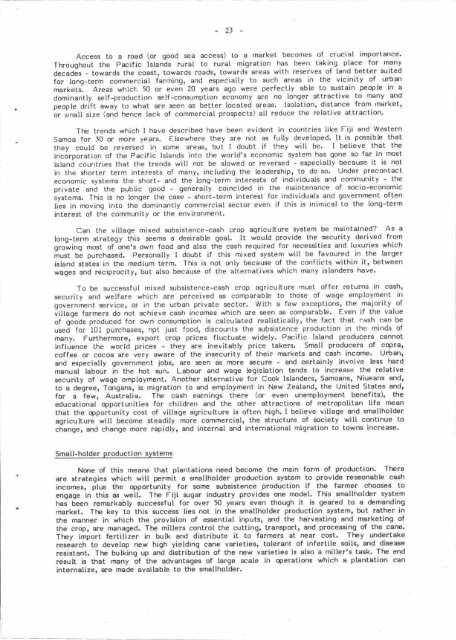Rt€@lll
Rt€@lll
Rt€@lll
You also want an ePaper? Increase the reach of your titles
YUMPU automatically turns print PDFs into web optimized ePapers that Google loves.
-2J<br />
Access to a road (or good sea access) to a market becomes of crucial importance.<br />
Throughout the Pacific Islands rural to fural migration has been Lakinq place for many<br />
decadis - towards the coast, towards roads, towards areas with reserves of land better suited<br />
f or long-term comrnercial f anming, and especially to such areas in the vicinity of urban<br />
markets. Areas which 50 or even 20 years ago were perfectly able to sustain people in a<br />
dominantly self -production self -consumption economy are no lonqer attractive to many and<br />
people drift away to what are seen as better located areas. Isolation, dislance from market'<br />
or small size (and hence lack of commercial prospects) all reduce the relative attraction.<br />
The trends which I have described have been evident in countries like Fiji and Western<br />
Samoa fon l0 or more years. Elsewhere they are not as fully developed. lt is possible that<br />
they could be reversed in some areas, but I doubt if they will be. I believe lhat the<br />
incorporatio.n of the Pacific Islands into Lhe wonld's economic system has gone so far in most<br />
island counlries that the trends wilt not be slowed or reversed - especially because it is not<br />
in the shorter term interests of many, including the leadership, to do so. Under precontact<br />
economic systems the short- and the long-Lerm interest.s of individuals and community - the<br />
private and the public good - generally coincided in the mainlenance of socio-economic<br />
sys!ems. This is no longer-the casl - short-term interest for individuals and government often<br />
lies in moving into the dominantly commencial secLor even if Lhis is inimical to the long-term<br />
inLerest of the community or the environment.<br />
Can the village mixed sJbsistence-cash crop agriculture system be maintained? As a<br />
long-term strategy [hir t"urr a desirable goal. It would provide the security derived from<br />
g.oiuing most of oners own food and also the cash required for necessities and luxuries which<br />
must bL purchased. Personally I doubt if this mixed system will be favoured in the larger<br />
island states in the medium term. This is not only because of the conflicts wiLhin it, between<br />
wages and reciprocity, but also because of lhe alternalives which many islanders have.<br />
To be successful mixed subsistence-cash cnop agriculture must offer neturns in casht<br />
security and welfare which are perceived as comparable to those of wage employment itt<br />
government service, or in the urban privaLe sector. With a few exceptions, the majority of<br />
iittage farmers do not achieve cash incomes which are seen as comparable. Even if the value<br />
of goods produced for o,vn consumption is calculated realistically' lhe fact that cash can be<br />
ur"i fo. I0l purchases, ngt just food, discounts the subsistence production in the minds of<br />
many. Furthermore, export crop prices fluctuate widely. Pacific Island producers cannot<br />
influence the world prices - they are inevitably price takers. Small producers of coprat<br />
eoffee or eocoa are very aware of the insecurity of their markets and cash income. Urbant<br />
and especially government jobs, are seen as more secure - and certainly involve less ttard<br />
manual labour in the hot 2n. Labour and wage legislation tends to increase the relative<br />
securiIy of wage employmenl. Another alternative for Cook lslanders, Samoens, Niueans and'<br />
to a degree, Tongans, is migration to and employment in New Zealand, the United Slates andt<br />
for a lew, Australia. The caeh earnings there (or even unemployment benef its)' the<br />
educational opportunities for children and the other attraciions of metropolitan life mean<br />
that the qportunity cost of village agniculture is often high. I believe village and smallholder<br />
agriculture will become steadily rnore commercial, the slructure of society will continue to<br />
change, and change more rapidly, and inLernal and intefnational migration to lowns increase.<br />
Small-holder production systems<br />
None of lhis means that plantations need become the main form of production. There<br />
are strategies which will permit a smallholder produetion system to provide reasonable cash<br />
incomes, plus the opportunily for some subsistence production if the farmer chooses to<br />
engage in this as well. The Fiii zugar industry provides one model. This smallholder system<br />
frai been remarkably successful for over 50 years even though it is geared to a demanding<br />
market.. The key to this success lies not in the smallholder pnoducLion system' but rather in<br />
the manner in which the provision of essential inputs, and the harvesting and merketing of<br />
the crop, €re menaged. The millers control the cutting, transpor!, and processing of the cane.<br />
They import fertilizer in bulk and distribute it to farmers at near cost. They undertake<br />
nesearch to develop new high yielding cane varieties, tolerant of infertile soils' and disease<br />
resistant. The bulking up and distribution of the new varieties is also a miller's task. The end<br />
result is lhat many of the advantages of large scale in operations which a plantation can<br />
internalize, are made available bo the smallholden.














![R]€@lll](https://img.yumpu.com/7594335/1/175x260/reurlll.jpg?quality=85)
